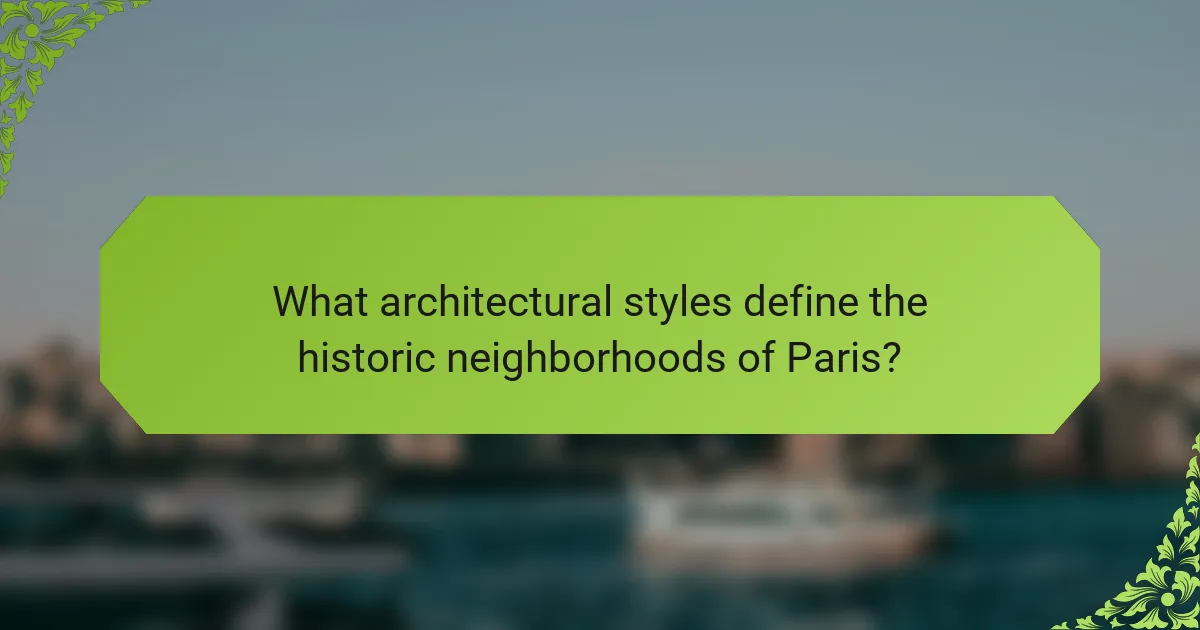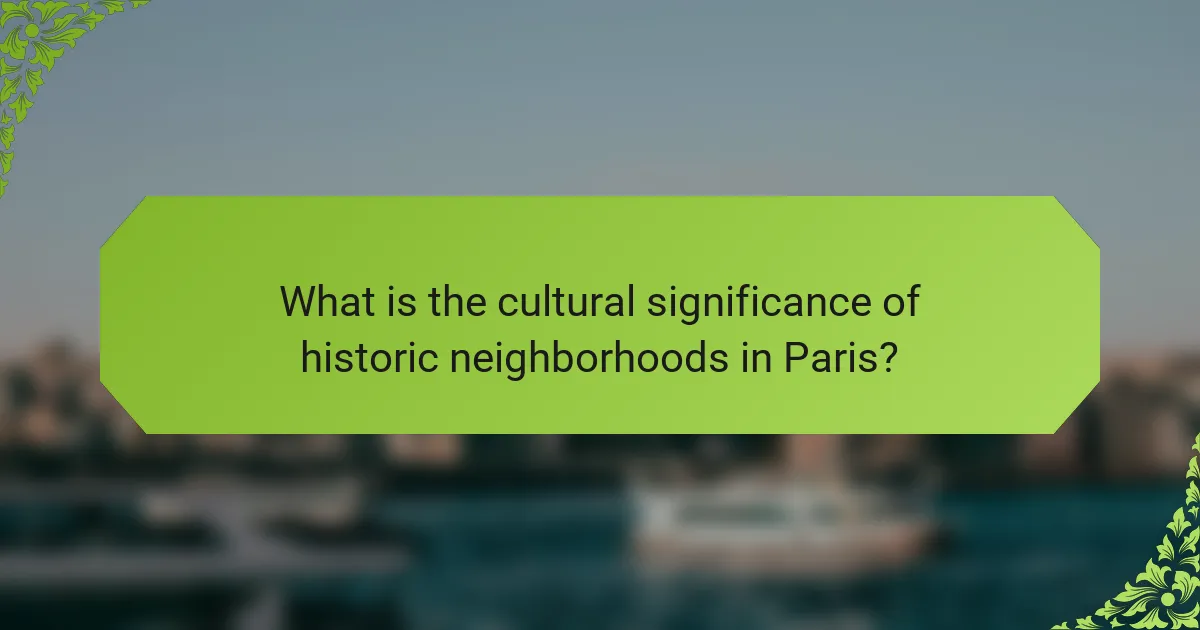Exploring the historic neighborhoods of Paris reveals diverse architectural styles and rich cultural significance. Discover the Gothic charm of Notre-Dame, the Haussmannian transformation of the 19th century, and the organic beauty of Art Nouveau. Key areas like Montmartre and Le Marais showcase the city’s artistic and social evolution. Gain practical tips for navigating these vibrant districts to enhance your experience.

What architectural styles define the historic neighborhoods of Paris?
The historic neighborhoods of Paris feature diverse architectural styles, including Gothic, Haussmannian, and Art Nouveau. Gothic architecture is prominent in structures like Notre-Dame, showcasing pointed arches and intricate details. Haussmannian style, characterized by uniform facades and wide boulevards, transformed Paris in the 19th century. Art Nouveau, with its organic forms and decorative elements, can be seen in buildings such as the metro entrances designed by Hector Guimard. Each style reflects the cultural significance and historical evolution of the city. Exploring these neighborhoods offers insights into Parisian heritage and urban development.
How do Haussmannian buildings influence the city’s aesthetic?
Haussmannian buildings significantly enhance Paris’s aesthetic through their uniformity, grand boulevards, and elegant facades. These structures, characterized by their neoclassical style, create a cohesive urban landscape. The use of light-colored stone and symmetrical designs contributes to a sense of harmony. As a result, they embody the city’s historical significance and cultural identity, attracting millions of visitors each year.
What are the characteristics of Gothic architecture in Paris?
Gothic architecture in Paris is characterized by pointed arches, ribbed vaults, and flying buttresses. These features create a vertical emphasis and allow for large stained glass windows, enhancing the interior light. Notable examples include Notre-Dame Cathedral and Sainte-Chapelle, showcasing intricate sculptures and detailed facades. The use of these elements not only defines the style but also reflects the cultural significance of the period in which it flourished.
Which neighborhoods showcase Renaissance architecture?
The neighborhoods of Le Marais, Saint-Germain-des-Prés, and the Latin Quarter prominently showcase Renaissance architecture. Le Marais features stunning mansions, while Saint-Germain-des-Prés is known for its historic churches. The Latin Quarter offers a blend of medieval and Renaissance styles, enriching Paris’s architectural narrative.
How does Art Nouveau manifest in Parisian streets?
Art Nouveau is prominently featured in Parisian streets through its organic forms and intricate designs. This architectural style, flourishing from the late 19th to early 20th century, emphasizes harmony between art and nature. Key examples include the iconic Metro entrances designed by Hector Guimard, showcasing sinuous lines and floral motifs. The style is evident in neighborhoods like the 11th arrondissement, where buildings adorned with decorative ironwork and stained glass reflect the cultural significance of this movement. Exploring these areas offers insights into Paris’s artistic heritage and urban aesthetics.

What is the cultural significance of historic neighborhoods in Paris?
Historic neighborhoods in Paris hold immense cultural significance as they embody the city’s rich history, artistic heritage, and social evolution. These areas, such as Montmartre and Le Marais, showcase diverse architectural styles that reflect various historical periods, attracting both locals and tourists.
The preservation of these neighborhoods highlights the importance of cultural identity and heritage. They serve as living museums, offering insights into Parisian life through art, cuisine, and traditions. For instance, Montmartre was a hub for artists like Picasso and Dali, while Le Marais represents the Jewish heritage and vibrant LGBTQ+ community.
Exploring these neighborhoods provides an immersive experience of Parisian culture. Visitors can appreciate historic landmarks, visit local markets, and participate in cultural events, deepening their understanding of the city’s unique character. The blending of history and modernity in these neighborhoods continues to shape Paris’s identity today.
How do these neighborhoods reflect Parisian history and identity?
Historic neighborhoods of Paris embody the city’s rich history and unique identity through their diverse architectural styles and cultural significance. Each area, such as Le Marais or Montmartre, showcases distinct historical influences, from medieval structures to Haussmannian boulevards. The preservation of these neighborhoods reflects Paris’s commitment to its heritage, allowing visitors to explore the evolution of art, culture, and society over centuries. Exploring these areas offers insights into the daily lives of Parisians throughout history, highlighting the blend of tradition and modernity that defines the city today.
Which cultural events are rooted in these historic areas?
Cultural events in historic neighborhoods of Paris include the Fête de la Musique, Nuit Blanche, and Bastille Day celebrations. These events highlight the neighborhoods’ artistic heritage and community spirit. The Fête de la Musique occurs annually on June 21, showcasing local musicians. Nuit Blanche, held in October, transforms the city into an all-night art festival. Bastille Day on July 14 celebrates French independence with parades and fireworks, particularly vibrant in historic areas like Le Marais and Montmartre. Each event reflects the unique cultural significance of these neighborhoods.
What role do local communities play in preserving cultural heritage?
Local communities are vital in preserving cultural heritage by actively participating in the maintenance and promotion of historic neighborhoods. They foster a sense of identity and belonging, which strengthens community ties. Community-led initiatives often include organizing cultural events, restoring historic buildings, and educating residents and visitors about local history.
For instance, in Paris, local groups advocate for the protection of architectural styles that reflect the city’s rich history. Their efforts ensure that unique attributes, such as the Haussmannian architecture, remain integral to the urban landscape. As a result, these neighborhoods not only retain their cultural significance but also attract exploration and tourism, further supporting their preservation.

How can visitors effectively explore historic neighborhoods in Paris?
Visitors can effectively explore historic neighborhoods in Paris by walking, using guided tours, or cycling. Each method provides unique insights into the architectural styles and cultural significance of the areas.
Walking allows for a personal connection with the surroundings, revealing details often missed in transit. Guided tours offer expert narratives, enhancing understanding of historical contexts. Cycling provides a broader view, connecting multiple neighborhoods efficiently.
Key neighborhoods include Le Marais, known for its medieval architecture, and Montmartre, famous for its artistic heritage. Exploring these areas during off-peak hours enhances the experience, allowing for a more intimate exploration of the rich history and vibrant culture.
What are the best walking routes for experiencing architectural highlights?
The best walking routes for experiencing architectural highlights in Paris include the Marais, Montmartre, and Saint-Germain-des-Prés. Each neighborhood showcases unique architectural styles and rich cultural significance.
The Marais features medieval buildings and stunning mansions, such as the Hôtel de Ville. Montmartre offers a bohemian atmosphere with the iconic Sacré-Cœur Basilica. Saint-Germain-des-Prés boasts elegant Haussmannian architecture and historic cafés, perfect for exploration.
These routes provide diverse architectural experiences, from Gothic to Art Nouveau styles, making them ideal for architecture enthusiasts.
Which local guides or tours enhance the exploration experience?
Local guides and tours that enhance the exploration of historic neighborhoods in Paris include specialized walking tours, architectural-focused excursions, and cultural immersion experiences. These options provide in-depth insights into architectural styles like Haussmannian and Gothic, as well as the neighborhoods’ cultural significance. Notable tours often highlight unique attributes, such as lesser-known historical facts and local artisan shops. Engaging with knowledgeable guides can enrich the exploration experience by offering context and personal stories tied to the sites.
What tips can help navigate the neighborhoods like a local?
To navigate the historic neighborhoods of Paris like a local, immerse yourself in the culture and architecture. Explore on foot to appreciate the intricate details of architectural styles, such as Haussmannian and Gothic. Engage with local markets and cafés to experience the vibrant community life. Utilize public transport to reach diverse areas efficiently, ensuring you visit lesser-known sites alongside famous landmarks. Learning a few basic French phrases can enhance interactions and enrich your experience.

What unique experiences can be found in specific Parisian neighborhoods?
Historic neighborhoods in Paris offer unique experiences through their distinct architectural styles and cultural significance. Montmartre is known for its bohemian charm and the iconic Sacré-Cœur Basilica. Le Marais features medieval buildings and vibrant art galleries. Saint-Germain-des-Prés is celebrated for its literary history and elegant cafés. Each neighborhood invites exploration with its unique atmosphere and historical landmarks.
How does Montmartre’s artistic history create a unique atmosphere?
Montmartre’s artistic history creates a unique atmosphere through its rich heritage and vibrant cultural scene. The neighborhood was a hub for renowned artists like Picasso and Van Gogh, fostering creativity. Its charming streets, iconic landmarks, and bohemian vibe enhance the experience for visitors. The interplay of historical architecture and artistic legacy contributes to Montmartre’s distinctive charm and allure.
What hidden gems are found in Le Marais district?
Le Marais district is rich with hidden gems, including unique boutiques, historic cafes, and art galleries. Notable sites include Place des Vosges, the oldest planned square in Paris, and the Musée Carnavalet, dedicated to the history of Paris. The district’s narrow streets are lined with charming architecture, showcasing a mix of medieval and Renaissance styles. Additionally, the vibrant Jewish Quarter offers authentic culinary experiences, enhancing the cultural significance of this historic neighborhood.
Which culinary delights are tied to the historic neighborhoods?
Historic neighborhoods in Paris are known for their culinary delights, each reflecting unique cultural influences. For example, Le Marais is famous for falafel, while Montmartre offers classic French bistros. The Latin Quarter is celebrated for its crepes and cafés. Each area features local specialties tied to its history, enhancing the exploration experience.

What are common mistakes to avoid when visiting historic neighborhoods in Paris?
To enhance your experience in Paris’s historic neighborhoods, avoid these common mistakes. Many visitors overlook the significance of local customs and etiquette, which can lead to misunderstandings. Failing to plan your itinerary can result in missing key sites, as some neighborhoods are best explored at specific times. Ignoring public transportation options may waste time; walking is not always feasible. Lastly, neglecting to engage with locals can diminish your experience; their insights often enrich exploration.
How can tourists avoid overcrowded areas while exploring?
Tourists can avoid overcrowded areas by exploring lesser-known historic neighborhoods in Paris. Consider visiting the Marais, known for its unique architecture and vibrant culture, or the Latin Quarter, rich in history and charm.
Plan visits during off-peak hours, typically early morning or late afternoon. Utilize local resources, such as guided walking tours that focus on quiet streets and hidden gems. Engage with locals to discover recommendations for less-traveled paths.
Exploring these neighborhoods not only enhances the experience but also allows for a deeper appreciation of Parisian culture and architecture.
What are the pitfalls of ignoring local customs and etiquette?
Ignoring local customs and etiquette can lead to misunderstandings and negative experiences. Visitors may offend locals, miss out on authentic interactions, and face social isolation. For example, disregarding dining etiquette in historic neighborhoods of Paris can result in unwelcoming responses from restaurant staff. Additionally, failing to appreciate cultural significance can diminish the value of exploration, turning a rich experience into a superficial one. Respecting local customs fosters positive connections and enhances the overall journey in Paris.
Which planning errors can detract from the experience?
Planning errors can significantly detract from the experience of exploring historic neighborhoods in Paris. Common mistakes include insufficient research on architectural styles, neglecting cultural significance, and failing to prioritize exploration tips.
Tourists often overlook the unique attributes of each neighborhood, such as the art deco influences in the 12th arrondissement or the medieval charm of Le Marais. Additionally, not accounting for time spent in each area can lead to rushed visits, diminishing the opportunity to appreciate the intricate details of Parisian architecture.
Neglecting local insights and guidance can also result in missed experiences, such as hidden cafés or art galleries. Therefore, thorough planning that incorporates these factors enhances the overall exploration experience.
What best practices ensure a rewarding visit to Paris’s historic neighborhoods?
To ensure a rewarding visit to Paris’s historic neighborhoods, plan your itinerary around key architectural styles, cultural significance, and exploration tips. Focus on neighborhoods like Le Marais and Montmartre, known for their rich history and unique charm.
Engage with local guides to uncover hidden gems and historical narratives. Allocate time for leisurely strolls to fully appreciate the stunning architecture, such as Haussmannian buildings and medieval structures.
Consider visiting during off-peak hours to avoid crowds and enhance your experience. Embrace local cuisine at traditional bistros and patisseries for an authentic taste of Parisian culture.
Lastly, immerse yourself in the art scene by exploring galleries and museums that reflect the neighborhoods’ artistic heritage, ensuring a comprehensive and enriching visit.



